Zhu Qizhen - the Zhengtong Emperor

The "Tumu Incident":
Mongols capture the imperial concubines
Peace lost in the empire

Zhu Qizhen, eldest son of the Xuande Emperor, succeeded his father to the throne on January 17, 1436 with reign title of Zhengtong.
Born 1427, he was only 8 years old at accession so until her death in 1442 his capable grandmother Zhang (the wife of the Hongxi Emperor) along with three ministers ensured that the empire was ruled in a benevolent way and as good as any government comes.
But his father's mistake of giving power to the eunuchs now came back to haunt his son.
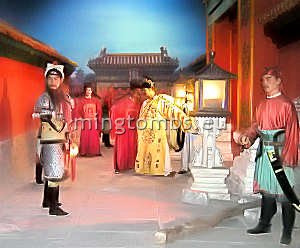
"Storming of The Gate Incident"
The Emperor's tutor, Palace Eunuch Wang Zhen, tricked his pupil into launching an ill-advised and ill-fated military campaign against the powerful Mongol leader Esen Khan in 1449. The Ming army was massacred at Tumu - some 70 kilometers northwest of Beijing - and the Emperor, his imperial concubines, impedimenta and ministers were all captured by the Mongols.
This defeat signaled the beginning of the end of the Ming Dynasty. With a few feeble exceptions the empire started a long slide downwards until finally overthrown in 1644.
Emperor for a Second Time !
While Zhu Qizhen was imprisoned by the Mongols a new Ming emperor, with reign title of Jingtai, was installed. The new reign refused to pay ransom for Zhu Qizhen and after a year, in September 1450, Esen Khan decided to release him.
He returned to Beijing but was placed in confinement in the Southern Palace of The Forbidden City until he managed to depose the Jingtai Emperor in a palace coup in 1457. In February of that year when the Jingtai Emperor fell critically ill Zhu Qizhen's collaborators rammed open the gate of the Southern Palace and overpowered the Emperor's guards. This is now known in Chinese history as the "Storming of the Gate Incident".
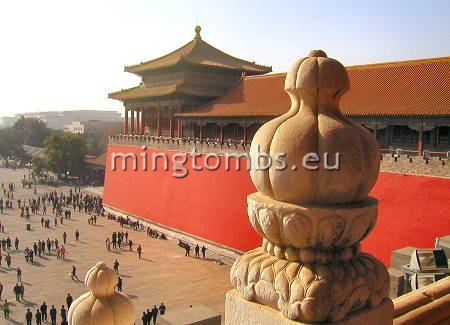
Eastern wing of Wumen -Forbidden City
After having demoted the Jingtai Emperor to the title of Prince, Zhu Qizhen installed himself as emperor, this time with a reign title of the Tianshun Emperor. He is the only Ming emperor who reigned twice!
Purging his Enemies -and Friends?
This his second reign was to be very different from the first. His grandmother, Empress Dowager Zhang, who had helped him as child emperor, had meanwhile passed away and the able ministers from back then had been purged by the Jingtai Emperor.
The long period of confinement and treason had made Zhu Qichen a very suspicious man and as the Tianshun Emperor he set out to take revenge. Not trusting his ministers he turned to the eunuchs and their secret police and with their support he killed or expelled over one million people.
The empire suffered greatly from the war with the Mongols, the reign of the Jingtai Emperor and the six year long quest for revenge by the Tianshun Emperor.
What had started out so well in 1436 ended so badly, when Zhu Qizhen died of illness aged 37 in 1464. He left behind a country in turmoil and an economy in decline. And even though the eunuchs were very much behind the start of the problems they had more power now than ever.
As one of his last impacts on the empire he ruled that concubines no longer be immolated alive with the deceased emperor (to await his arrival in death).

Yuling layout
Himself being unique by being emperor twice in his lifetime, Zhu Qizhen's tomb is nothing out of the ordinary for a Ming emperor.
In the ceremonial front yard behind the front gate only the ruins of a 5x3-room sized ceremonial hall bears any witness of past splendor.
A triple-door gate led into the rear burial area, which is equipped with sacrificial vessels, a "Square City" and a memorial tower on top.
Whereas the tomb itself is very dilapidated at least the wall around the precious mound itself is in reasonable shape.
The mausoleum is unfortunately closed to the general public.
Tomb location:

Google Earth:

Yuling - the fourth tomb, right?

Ruins of Memorial Shrine
the Tianshun Emperor was buried in a mausoleum named Yuling, the fourth tomb in the Ming dynastic imperial burial site around Tianshou Mountain.
Wait a minute! The count must be messed up. This should be the fifth tomb since the Jingtai Emperor actually died during Zhu Qizhen's second reign as the Tianshun Emperor, right?
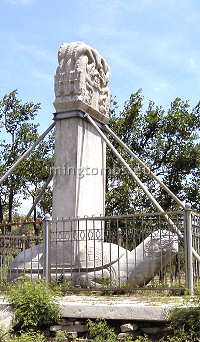
Divine Merit Stele
Well, technically yes, but there is a snag. The Jingtai Emperor indeed predeceased Zhu Qizhen, however, in his second term ruling as the Tianshun Emperor, Zhu Qizhen had demoted the Jingtai Emperor to that of a lowly Prince after having usurped the throne in the "Storming of the Gate Incident".
As a lowly prince the ex-Jingtai Emperor was no longer eligible to be laid to rest at the imperial mausoleum, Shishanling. Hence, Zhu Qizhen had the Jingtai Emperor's semi-finished mausoleum torn down and had him buried in Beijing's Western Hills with the honors proper for a prince only. In this way Yuling became the fourth tomb at the Ming mausoleum north of Beijing.
But only the surface parts of the Jingtai Emperor's tomb were demolished. The Underground Palace grave was merely abandoned and was incredulously "recycled" in 1620 when a tomb was needed quickly for the 14th Ming Taichang Emperor, who died suddenly and unexpectedly after reigning for only 29 days.
A medium sized tomb

Ruins of the front gate and southeast wall
Yuling only took four months to complete. Construction commenced in February 1464 right after Zhu Qizhen's death. The mausoleum covers a total area of 26,200 square meters including the tomb mound.
The previous two emperors had chosen the "best" sites just east and west of Changling, the first and central tomb of the Yongle Emperor. Zhu Qizhen therefore chose a location a few kilometers further northwest of Xianling, the tomb west of Changling.
Yuling is located at the southern foot of Mt. Shimen ("Stone Gate") of the western peak of Tianshou Mountain Range ("Mountain of Heavenly Longevity").

Maoling and Kangling (rear) seen from Yuling
In fact, the chosen site for Yuling was just so much further northwest that another Ming emperor, the Taichang Emperor (r.1620), later had his tomb, Qingling, built between Yuling and Xianling.
However, Yuling still lies at a higher elevation than all the other tombs built in front of Mt. Tianshou ridges. In fact, on a clear day all of the following tombs can be seen when standing next to Yuling: Changling, Xianling, Qingling, Maoling, Kangling and even Dingling.
A loyal wife
Yuling is the resting place for Zhu Qizhen, alias the Zhengtong Emperor, alias the Tianshun Emperor. Entombed with him are his two empresses, Qian and Zhou.

Zhu Qizhen's gratitude:
Empress Qian shall lie with me in the same grave for more than a thousand autumns and ten thousand years.
Empress Qian was childless and hence to ensure hereditary succession the emperor had taken a second empress, Zhou, who gave birth to (at least) one son, the subsequent ruler of the dynasty.
But although empress Qian had been put aside she remained loyal and supportive to Zhu Qizhen and stood by his side through the seven years of "house arrest". Her devotion moved the otherwise ruthless emperor to the point where he publicly announced his appreciation -see the inserted quotation.

Eastern wall (note support lower left)
The emperor is also known for having ordered that his concubines not be buried alive with him.
Whatever is left ...
Yuling was only equipped with the basic constructions of an imperial Ming tomb. In general, the mausoleum lies pretty dilapidated in bad need of some brush-up.
The front gate was a 3 by 2-room structure of which just pieces of the side walls are extant. The surrounding walls still stand but the eastern front corner has broken apart and has been reinforced with a concrete block to keep it from collapsing altogether.
Only part of the rear wall of the sacrificial hall remains. It was a 5 by 3 room structure, which can be deducted from the remaining stone pillar supports. The triple gate into the burial area has collapsed as has part of the wall separating the two areas. There never was a Ling Xing gate and the stone sacrificial vessels are missing. But at least their base platform still stands.

The dilapidated Soul Tower of Yuling
The memorial tower on top of the "Square City" still stands but is heavily dilapidated. Grass growing in the roof is little by little eroding the fine structure.
The wall around the Precious Mound still stands but trees and general shrubs are gradually tearing it down from within.
This section of the wall is kept in the original gray color whereas the southern wall section has been painted in vermilion color.
The walls separating the sacrificial and burial areas and connecting the outer walls to the triple gate have collapsed and the ruins removed. Otherwise, the gate itself has been restored.

The broken SE corner
Tomb occupants
Three persons are entombed in Yuling: the Zhengtong emperor, Empress Qian and Empress Dowager Zhou.
Empress Qian, formally Empress Xiaozhuang Rui, came from Haizhou, Huaianfu (today's Lianyungang City, Jiangsu Province) and was the first wife of Emperor Zhengtong.
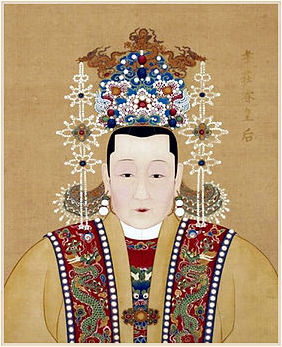
Empress Qian (1426-68)
She was born in 1426 as Qian Jinluan. Her father's name was Qian Gui, but her mother is unknown.
She was promoted to empress in 1442, but when her husband was captured by the Mongols and named "Retired Emperor" in 1449, she was deposed and moved from the imperial court to separate quarters in The Forbidden City to allow the "replacement" emperor's wife to assume the title of Empress Consort.
When her husband was returned by the Mongols 19 September 1450, she voluntarily chose to join him in house arrest in a guarded area of The Forbidden City. She stayed there with him in physical hardship until 11 February 1457, when he was reinstated as Emperor after the "Storming of The Gate Incident".
Empress Qian became Empress Dowager Ciyi ("benevolent and ideally virtuous") in 1464 with the passing away of her husband.
She died childless 43 lunar years old in 1468 and was buried in a separate chamber of the Yu Ling two months after her passing. In show of respect to her loyalty her memorial tablet was placed next to that of the late Tianshun Emperor in the Imperial Ancestral Temple, southeast of The Forbidden City.
Empress Dowager Shengci was born 1430 as Lady Zhou from Beijing, more specifically Liulin village, today's Haidian District. Her father was Zhou Neng, Duke Rongjing of Ning. Her mother is only known as Lady Zhen, Madame of Ning.
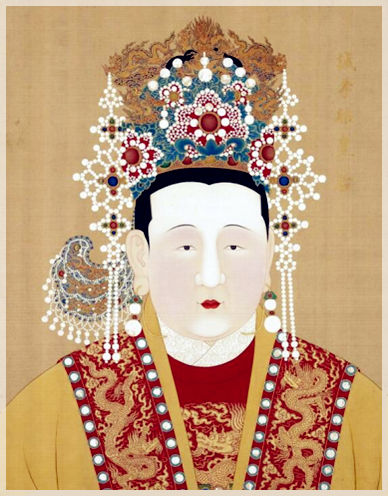
Empress Dowager Shengci (1430-1504)
As a consort to the Zhengtong Emperor, she gave birth to the Heir Apparent, the later Chenghua Emperor, in 1447. He was sent to live in hardship with Empress Qian during her six and a half years of house arrest in The Forbidden City.
When in 1457 Zhu Qizhen re-ascended the throne he promoted Lady Zhou to imperial concubine of first rank or "Noble Consort", being the mother of the Heir Apparent.
When in 1465 her son ascended the throne she insisted on the title and rank of Empress Dowager since she was the biological mother of the Emperor. Empress Qian claimed her right to the same title due to the immense loyalty she had shown to the deceased Zhengtong Emperor as well as to the Cenghua Emperor while he was still a child under house arrest.
The Chenghua Emperor could not make any of the two yield to the other and in the end decided to bestow the title of Empress Dowager onto both. Empress Qian however was overall treated in court as the higher ranking of the two.
Lady Zhou became Grand Empress Dowager in 1487 as Zhu Youtang ascended the throne as the Hongzhi Emperor. She passed away in 1504 and was the last person to be entombed in Yuling.
Yuling is not accessible to the general public. It lies quietly and desolated off the small rural road which snakes from tomb to tomb northwest of Changling. To the best of my knowledge, it has not been opened since Lady Zhou was buried here in 1504.